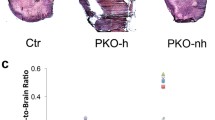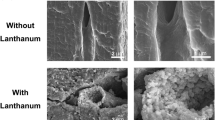Abstract
Brain development occurs in a specialized environment maintained by a blood–brain barrier (BBB). An important structural element of the BBB is the endothelial tight junction (TJ). TJs are present during the embryonic period, but BBB impermeability accrues over an extended gestational interval. In studies of human premature infants, we used immunomicroscopy to determine if amounts of the TJ proteins ZO-1, claudin and occludin increase with gestational age in vessels of germinal matrix (GM) and cortex. By 24 weeks postconception (PC), TJ proteins were present in both GM and cortical vessels, but immunoreactivity in the GM of the youngest subjects was less than in older subjects. At 24 weeks PC, TJ protein immunoreactivity in GM vessels was less than in cortical vessels suggesting that TJ maturation progresses along a superficial to deep brain axis. This concept correlates with conclusions from previous analyses of the expression of brain endothelial cell alkaline phosphatase (AP) activity. AP appears in cortical vessels before appearing in deep white matter and GM vessels. Together, these data indicate that differentiation of some functional specializations is still in progress in GM vessels during the third trimester. This maturation could relate to the pathogenesis of germinal matrix hemorrhage–intraventricular hemorrhage.





Similar content being viewed by others
References
Anstrom JA, Brown WR, Moody DM, Thore CR, Challa VR, Block SM (2002) Temporal expression pattern of cerebrovascular endothelial cell alkaline phosphatase during human gestation. J Neuropathol Exp Neurol 61:76–84
Anstrom JA, Thore CR, Moody DM, Challa VR, Block SM, Brown WR (2005a) Histological analysis of vascular patterns and connections in the germinal matrix of premature neonates. Neuroembryol 3:4–12
Anstrom JA, Thore CR, Moody DM, Challa VR, Block SM, Brown WR (2005b) Morphometric assessment of collagen accumulation in germinal matrix vessels of premature human neonates. Neuropathol Appl Neurobiol 31:181–190
Ballabh P, Braun A, Nedergaard M (2004) The blood–brain barrier: an overview: structure, regulation, and clinical implications. Neurobiol Dis 16:1–13
Ballabh P, Hu F, Kumarasiri M, Braun A, Nedergaard M (2005) Development of tight junction molecules in blood vessels of germinal matrix, cerebral cortex, and white matter. Pediatr Res 58:791–798
Bass T, Singer G, Slusser J, Liuzzi FJ (1992) Radial glial interaction with cerebral germinal matrix capillaries in the fetal baboon. Exp Neurol 118:126–132
Bauer HC, Bauer H (2000) Neural induction of the blood–brain barrier: still an enigma. Cell Mol Neurobiol 20:13–28
Bell MA, Scarrow WG (1984) Staining for microvascular alkaline phosphatase in thick celloidin sections of nervous tissue: morphometric and pathological applications. Microvasc Res 27:189–203
Bolton SJ, Anthony DC, Perry VH (1998) Loss of the tight junction proteins occludin and zonula occludens-1 from cerebral vascular endothelium during neutrophil-induced blood–brain barrier breakdown in vivo. Neuroscience 86:1245–1257
Davies DC (2002) Blood–brain barrier breakdown in septic encephalopathy and brain tumours. J Anat 200:639–646
Dobrogowska DH, Vorbrodt AW (2004) Immunogold localization of tight junctional proteins in normal and osmotically-affected rat blood–brain barrier. J Mol Histol 35:529–539
el Hafny B, Bourre JM, Roux F (1996) Synergistic stimulation of gamma-glutamyl transpeptidase and alkaline phosphatase activities by retinoic acid and astroglial factors in immortalized rat brain microvessel endothelial cells. J Cell Physiol 167:451–460
Ghazi-Birry HS, Brown WR, Moody DM, Challa VR, Block SM, Reboussin DM (1997) Human germinal matrix: venous origin of hemorrhage and vascular characteristics. AJNR Am J Neuroradiol 18:219–229
Hamm S, Dehouck B, Kraus J, Wolburg-Buchholz K, Wolburg H, Risau W, Cecchelli R, Engelhardt B, Dehouck MP (2004) Astrocyte mediated modulation of blood–brain barrier permeability does not correlate with a loss of tight junction proteins from the cellular contacts. Cell Tissue Res 315:157–166
Hirase T, Staddon JM, Saitou M, Ando-Akatsuka Y, Itoh M, Furuse M, Fujimoto K, Tsukita S, Rubin LL (1997) Occludin as a possible determinant of tight junction permeability in endothelial cells. J Cell Sci 110(Pt 14):1603–1613
Kniesel U, Risau W, Wolburg H (1996) Development of blood–brain barrier tight junctions in the rat cortex. Brain Res Dev Brain Res 96:229–240
Knust E, Bossinger O (2002) Composition and formation of intercellular junctions in epithelial cells. Science 298:1955–1959
Lenn NJ, Whitmore L (1985) Gestational changes in the germinal matrix of the normal rhesus monkey fetus. Pediatr Res 19:130–135
Liebner S, Fischmann A, Rascher G, Duffner F, Grote EH, Kalbacher H, Wolburg H (2000) Claudin-1 and claudin-5 expression and tight junction morphology are altered in blood vessels of human glioblastoma multiforme. Acta Neuropathol (Berl) 100:323–331
Lippoldt A, Jansson A, Kniesel U, Andbjer B, Andersson A, Wolburg H, Fuxe K, Haller H (2000a) Phorbol ester induced changes in tight and adherens junctions in the choroid plexus epithelium and in the ependyma. Brain Res 854:197–206
Lippoldt A, Liebner S, Andbjer B, Kalbacher H, Wolburg H, Haller H, Fuxe K (2000b) Organization of choroid plexus epithelial and endothelial cell tight junctions and regulation of claudin-1, -2 and -5 expression by protein kinase C. Neuroreport 11:1427–1431
Ment LR, Stewart WB, Ardito TA, Madri JA (1991) Beagle pup germinal matrix maturation studies. Stroke 22:390–395
Ment LR, Stewart WB, Ardito TA, Huang E, Madri JA (1992) Indomethacin promotes germinal matrix microvessel maturation in the newborn beagle pup. Stroke 23:1132–1137
Ment LR, Oh W, Ehrenkranz RA, Philip AG, Schneider K , Katz KH, Taylor KJ, Duncan CC, Makuch RW (1993) Risk period for intraventricular hemorrhage of the preterm neonate is independent of gestational age. Semin Perinatol 17:338–341
Ment LR, Stewart WB, Ardito TA, Madri JA (1995) Germinal matrix microvascular maturation correlates inversely with the risk period for neonatal intraventricular hemorrhage. Brain Res Dev Brain Res 84:142–149
Mizuguchi H, Fujii A, Utoguchi N, Nakagawa S, Mayumi T (1995) Glial-conditioned medium elevates alkaline phosphatase activity in cultured bovine aortic endothelial cells. Microvasc Res 50:129–132
Mollgard K, Saunders NR (1986) The development of the human blood–brain and blood–CSF barriers. Neuropathol Appl Neurobiol 12:337–358
Nakazato H, Deguchi M, Fujimoto M, Fukushima H (1997) Alkaline phosphatase expression in cultured endothelial cells of aorta and brain microvessels: induction by interleukin-6-type cytokines and suppression by transforming growth factor betas. Life Sci 61:2065–2072
Papadopoulos MC, Saadoun S, Woodrow CJ, Davies DC, Costa-Martins P, Moss RF, Krishna S, Bell BA (2001) Occludin expression in microvessels of neoplastic and non-neoplastic human brain. Neuropathol Appl Neurobiol 27:384–395
Povlishock JT, Martinez AJ, Moossy J (1977) The fine structure of blood vessels of the telencephalic germinal matrix in the human fetus. Am J Anat 149:439–452
Risau W, Hallmann R, Albrecht U (1986) Differentiation-dependent expression of proteins in brain endothelium during development of the blood–brain barrier. Dev Biol 117:537–545
Rubin LL, Staddon JM (1999) The cell biology of the blood–brain barrier. Annu Rev Neurosci 22:11–28
Saunders NR, Habgood MD, Dziegielewska KM (1999) Barrier mechanisms in the brain, II. Immature brain. Clin Exp Pharmacol Physiol 26:85–91
Sobue K, Yamamoto N, Yoneda K, Hodgson ME, Yamashiro K, Tsuruoka N, Tsuda T, Katsuya H, Miura Y, Asai K, Kato T (1999) Induction of blood–brain barrier properties in immortalized bovine brain endothelial cells by astrocytic factors. Neurosci Res 35:155–164
Stewart PA, Hayakawa K (1994) Early ultrastructural changes in blood–brain barrier vessels of the rat embryo. Brain Res Dev Brain Res 78:25–34
Tsukita S, Furuse M (1998) Overcoming barriers in the study of tight junction functions: from occludin to claudin. Genes Cells 3:569–573
Virgintino D, Errede M, Robertson D, Capobianco C, Girolamo F, Vimercati A, Bertossi M, Roncali L (2004) Immunolocalization of tight junction proteins in the adult and developing human brain. Histochem Cell Biol 122:51–59
Volpe JJ (2001) Neurology of the newborn, 4 edn. W.B. Saunders Co, Philadelphia
Vorbrodt AW, Dobrogowska DH (2003) Molecular anatomy of intercellular junctions in brain endothelial and epithelial barriers: electron microscopist’s view. Brain Res Brain Res Rev 42:221–242
Vorbrodt AW, Dobrogowska DH (2004) Molecular anatomy of interendothelial junctions in human blood–brain barrier microvessels. Folia Histochem Cytobiol 42:67–75
Vorbrodt AW, Lossinsky AS, Wisniewski HM (1986) Localization of alkaline phosphatase activity in endothelia of developing and mature mouse blood–brain barrier. Dev Neurosci 8:1–13
Vorbrodt AW, Dobrogowska DH, Tarnawski M (2001) Immunogold study of interendothelial junction-associated and glucose transporter proteins during postnatal maturation of the mouse blood–brain barrier. J Neurocytol 30:705–716
Wakai S, Hirokawa N (1978) Development of the blood–brain barrier to horseradish peroxidase in the chick embryo. Cell Tissue Res 195:195–203
Wolburg H, Lippoldt A (2002) Tight junctions of the blood–brain barrier: development, composition and regulation. Vascul Pharmacol 38:323–337
Wolburg H, Wolburg-Buchholz K, Liebner S, Engelhardt B (2001) Claudin-1, claudin-2 and claudin-11 are present in tight junctions of choroid plexus epithelium of the mouse. Neurosci Lett 307:77–80
Wolburg H, Wolburg-Buchholz K, Kraus J, Rascher-Eggstein G, Liebner S, Hamm S, Duffner F, Grote EH, Risau W, Engelhardt B (2003) Localization of claudin-3 in tight junctions of the blood–brain barrier is selectively lost during experimental autoimmune encephalomyelitis and human glioblastoma multiforme. Acta Neuropathol (Berl) 105:586–592
Acknowledgments
We thank Patricia Wood and Carolyn Cox for their expert technical assistance in the preparation of histological slides. The project described was supported by a gift from the Kulynych Family as well as by Grant Numbers NS 20618 and NS 36780 to DMM from the NIH, and grant 1064 from the March of Dimes to WRB. Its contents are solely the responsibility of the authors and do not necessarily represent the official views of the National Institute of Neurological Diseases and Stroke.
Author information
Authors and Affiliations
Corresponding author
Rights and permissions
About this article
Cite this article
Anstrom, J.A., Thore, C.R., Moody, D.M. et al. Immunolocalization of tight junction proteins in blood vessels in human germinal matrix and cortex. Histochem Cell Biol 127, 205–213 (2007). https://doi.org/10.1007/s00418-006-0232-z
Accepted:
Published:
Issue Date:
DOI: https://doi.org/10.1007/s00418-006-0232-z




